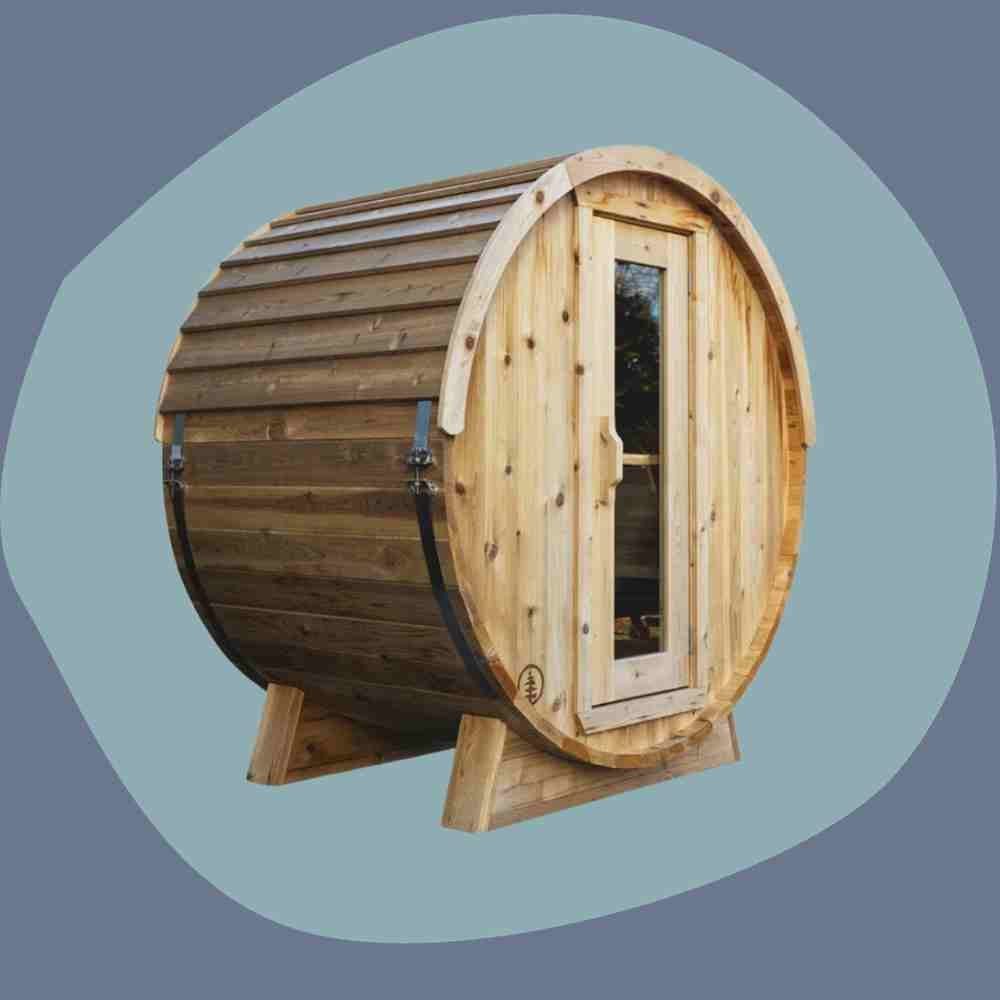Traditional vs Infrared vs Steam Saunas – Differences, Benefits and Risks
We include links to products we think are useful for our readers. If you click and buy a product through one of the affiliate links on this page, we may earn a small commission.

Saunas have been an integral part of human culture and well-being for centuries. These heat therapy chambers have evolved over time, and today, there are various types of saunas available, each with its unique characteristics and benefits.
While much of the research pertaining to the benefits of sauna have been conducted using traditional saunas, infrared saunas, and steam saunas also offer the heat stimulus or heat stress that is great for our health on so many levels.
Here, we will delve deep into the differences between these three types of saunas, explain their subtle differences including their operating temperature, how they function, discuss the typical duration to aim for, and provide an extensive overview of their respective health benefits, substantiated by scientific studies.
Key Takeaways
Embracing regular sauna sessions can provide a range of advantages, including muscle relaxation, enhanced circulation, and improved skin well-being, improved sleep, heat adaptations, improved overall markers of health and lower risk of all cause mortality
The ideal duration for a sauna session typically falls within the 15-20 minute range. If you’re new to saunas, it’s advisable to commence with shorter sessions of 5-10 minutes to acclimate.
It’s important to note that individuals with specific medical conditions should refrain from sauna use. If you’re uncertain about your suitability for sauna bathing after reading this article, seek guidance from a healthcare professional.
Sauna experiences can vary based on the type, whether it’s a traditional sauna, a steam sauna, or an infrared sauna. Each offers distinct temperature and humidity levels, catering to different preferences and goals.
For all cause mortality “sauna bathing 2 to 3 times per week was associated with a 24 percent lower risk, and 4 to 7 times per week with a 40 percent reduction in risk compared to only one sauna session per week.” This underscores the potential benefits of incorporating regular sauna bathing into your routine for improved well-being.
Benefits of Sauna Use
Enhanced Detoxification Pathways
Our body employs various mechanisms to rid itself of toxins and heavy metals. Among these, our skin, our largest organ, plays a significant role by aiding detoxification through sweat.
As one study highlights, “an often overlooked route of excretion of toxicants is via the process of sweating.” With the growing prevalence of chemical exposure in our lives, sweat serves as a means to eliminate harmful substances, including heavy metals like lead, mercury, and arsenic.
Accelerated Muscle Recovery and Endurance
For those grappling with post-workout muscle soreness, sauna sessions can expedite the recovery process, particularly after endurance training.
While the benefits for maximum lifts and heavy lifting are less pronounced, sauna use can significantly enhance endurance performance, as evidenced by studies indicating a remarkable 30% increase in run time to exhaustion.
Muscle Growth and Heat Shock Proteins
Sauna use isn’t just about relaxation; it can also contribute to muscle growth.
Research shows that hyperthermia induced by sauna sessions can elevate heat shock protein expression, fostering muscle regrowth in response to exercise-induced micro-injuries.
Elevation of Growth Hormones
The relationship between sauna use and growth hormone release is intriguing. The extent of growth hormone release varies based on factors such as time, temperature, and frequency.
For instance, two 20-minute sauna sessions at 80°C (176°F), separated by a 30-minute cooling period, can double growth hormone levels.
Conversely, two 15-minute sauna sessions at 100°C (212°F), with cooling intervals, can result in a five-fold increase in growth hormone levels.
Enhanced Insulin Sensitivity
Poor insulin sensitivity can lead to weight gain, inflammation, and diabetes.
Sauna-induced hyperthermia has been shown to improve insulin resistance, making it a valuable tool for individuals dealing with diabetes and insulin-related weight issues. Improved insulin sensitivity is a key factor in achieving metabolic health.
Augmented Nitric Oxide Bioavailability
Nitric oxide (NO) plays a pivotal role in vasodilation, enhancing blood flow to muscles and serving various other important functions in the body.
Sauna use has been found to increase NO bioavailability, promoting better blood circulation and potentially benefiting both men and women, including potential benefits for sexual health in men.
Heat Acclimation and Improved Performance
Exposing the body to heat stressors, similar to sauna conditions, can enhance one’s ability to perform in hot and humid environments.
A study involving female athletes demonstrated improvements in thermoregulation, cardiovascular function, and perceived strain after five days of sauna-like heat exposure, with daily sessions lasting 20 minutes.
Caloric Burn and Weight Management
Sauna sessions naturally burn calories due to the thermogenic effects of the heat. As we sweat to cool down our bodies, we expend calories in the process.
However, it’s important to note that the weight loss following sauna use primarily consists of fluids. Proper hydration before, during, and after sauna sessions is essential.
Pain Reduction and Increased Beta-Endorphins
Sauna use can stimulate the release of beta-endorphins, natural pain-relieving compounds.
Studies suggest that sauna-induced stress responses trigger the production of beta-endorphins, contributing to pain reduction.
This effect extends to headache relief, making sauna bathing a potentially effective treatment for reducing headache intensity.
Improved Sleep Quality
Raising your body temperature in a sauna session just before bedtime can help induce deeper sleep.
The body’s post-sauna cooling and normalization process can facilitate a calm and relaxed state conducive to sound sleep throughout the night.
Positive Impact on Brain Health
Research reveals several promising aspects of sauna use for brain health, including reduced risk of cardiovascular disease and all-cause mortality, as well as a decreased likelihood of developing dementia and Alzheimer’s disease.
Sauna sessions, known for promoting relaxation and well-being, may be a valuable intervention for preserving cognitive health in healthy adults.
Social Benefits of Sauna
While not rooted in science, the social aspect of sauna sessions should not be overlooked. Saunas have served as venues for diverse and meaningful conversations.
Sharing a sauna with others, whether one or twenty individuals, provides an opportunity for engaging discussions, often resulting in problem-solving and bonding.
Extended Lifespan
For those seeking to maximize both the quality and quantity of life, frequent sauna use offers promising benefits. Studies indicate that increased sauna frequency is associated with a reduced risk of all-cause mortality. For instance, men who use the sauna two to three times weekly were found to be 27% less likely to die from cardiovascular-related causes than those who did not.
Enhanced Sense of Well-Being
Endorphins, often referred to as the “feel-good” hormones, play a crucial role in mood enhancement. Just as a rigorous workout can elevate your mood, sauna sessions have a similar effect.
Recent studies suggest that whole-body hyperthermia, such as that induced by sauna use, holds potential as a safe and rapid-acting antidepressant modality with lasting therapeutic benefits.
Additionally, sauna use can reduce the stress hormone cortisol, contributing to an overall sense of well-being.
Differences Between Traditional, Infrared and Steam Saunas
Here’s a brief overview of the distinctions between traditional, infrared, and steam saunas:
Heating Method:
Traditional Saunas: Heat the air within the sauna chamber.
Infrared Saunas: Utilize infrared light to directly warm the body.
Steam Saunas: Generate steam to raise the humidity and temperature.
Heat Intensity:
Traditional Saunas: Operate at high temperatures, often exceeding 150°F (65.6°C), up to 212°F (100°C)
Infrared Saunas: Use lower temperatures, typically between 120°F to 158°F (48.9°C to 70°C).
Steam Saunas: Maintain moderate to high humidity and lower temperatures, around 110°F to 120°F (43.3°C to 48.9°C).
Sauna Benefits:
Traditional Saunas: Promote relaxation and a deep sweat, with potential benefits for cardiovascular health.
Infrared Saunas: Offer increased comfort, are convenient for home use, and are usually more cost-effective.
Steam Saunas: Create a moist environment, aiding with respiratory conditions, and can induce relaxation.
Sauna Disadvantages:
Traditional Saunas: May feel uncomfortably hot for some individuals, require more energy to maintain high temperatures.
Infrared Saunas: Have limited research on long-term health effects, might be influenced by marketing claims, and can pose potential electromagnetic field (EMF) risks.
Steam Saunas: Require a source of water, potentially leading to maintenance and mould issues, and may not reach the high temperatures of traditional saunas.
Traditional Saunas
Traditional saunas, also known as Finnish saunas, are perhaps the most recognized and historically significant saunas. They use a conventional heating method involving rocks or electric heaters to produce a dry, radiant heat. These saunas typically operate at high temperatures, typically between 160°F to 1212°F (71°C to 100°C). Users in traditional saunas experience a dry heat, and humidity levels are relatively low, usually below 20%.

Price: $6995 USD (use code GURU for 4% off)
Warranty: 5 year limited warranty
Size: 2 people
Heater: HUM WIFI Heater
Operating Temperature and Duration
Traditional saunas, as mentioned, operate at higher temperatures. The recommended duration for a traditional sauna session is typically between 15 to 20 minutes. However, individual tolerance may vary, and beginners should start with shorter sessions and gradually increase their duration. There is evidence that there is a diminishing return of the benefits of sauna after about 30 minutes of use.
Traditional Sauna Health Benefits
Cardiovascular Health: Traditional saunas are known for their potential cardiovascular benefits. A study published in the Journal of Human Hypertension in 2018 found that regular sauna use is associated with a reduced risk of hypertension, a major risk factor for cardiovascular diseases. The heat exposure in traditional saunas leads to increased heart rate and improved blood flow, which can be likened to a mild workout.
Stress Reduction: Sauna bathing, including traditional saunas, has been shown to have stress-reducing effects. A study in the Journal of Physiological Anthropology and Applied Human Science in 2003 found that sauna bathing decreases levels of the stress hormone cortisol.
Detoxification: Sweating is a natural way for the body to eliminate toxins, and traditional saunas induce profuse sweating. A study published in the journal Environmental International in 2018 stated that saunas can help in the excretion of various toxic chemicals from the body.
Improved Skin Health: The dry heat in traditional saunas can open pores, cleanse the skin, and promote a healthy complexion. The sweating process helps remove dead skin cells and impurities, leading to improved skin texture.
Infrared Saunas
Infrared saunas are a more recent addition to the world of heat therapy. Instead of heating the air around you, infrared saunas use infrared radiant heat to directly heat the body. Infrared saunas typically operate at lower temperatures, ranging from 120°F to 158°F (49°C to 70°C). Despite the lower temperature, users often report feeling the heat more intensely due to its direct penetration of the skin.
A more detailed explanation: How Infrared Saunas Work
Operating Temperature and Duration
Infrared saunas operate at lower temperatures compared to traditional saunas. A typical session in an infrared sauna may last between 20 to 30 minutes, but individual tolerance and preference play a role in determining the duration.
Infrared Sauna Health Benefits
Pain Relief: Infrared saunas have been shown to alleviate various types of pain, including muscle and joint pain. A study published in the Clinical Rheumatology journal in 2009 found that infrared saunas provided significant pain relief for patients with rheumatoid arthritis and ankylosing spondylitis.
Improved Circulation: Infrared heat can promote better blood circulation. A study in the journal Acta Medica Okayama in 2008 found that infrared sauna therapy improved blood flow in patients with congestive heart failure.
Weight Loss: While not a substitute for proper diet and exercise, some research suggests that infrared saunas may aid in weight loss. A study published in the Journal of the American Medical Association in 1981 reported that a 30-minute session in an infrared sauna could burn approximately 600 calories.
Detoxification: Similar to traditional saunas, infrared saunas can also aid in detoxification by promoting sweating. A study in the Journal of Environmental and Public Health in 2012 suggested that infrared saunas may help eliminate heavy metals from the body.
Steam Saunas
Steam saunas, also known as steam rooms, utilize moist heat generated by boiling water to produce steam. The temperature in steam saunas is typically lower than that in traditional saunas, ranging from 100°F to 120°F (38°C to 49°C). These saunas are known for their high humidity levels, usually exceeding 90%.
Operating Temperature and Duration
Steam saunas operate at relatively lower temperatures compared to traditional saunas. Due to the high humidity, sessions in steam saunas tend to be longer, often lasting 20 to 30 minutes or even more. The lower temperature allows for longer, more comfortable sessions.
Steam Sauna Health Benefits
Respiratory Health: Steam saunas are known for their positive effects on respiratory health. The moist, warm air can help alleviate symptoms of conditions like asthma, allergies, and sinusitis. A study published in the Journal of Occupational and Environmental Medicine in 2017 found that regular use of steam saunas reduced the risk of respiratory diseases.
Skin Hydration: The high humidity in steam saunas can be beneficial for the skin, helping to hydrate it and potentially improve conditions like dry skin and eczema.
Stress Reduction: Like other saunas, steam saunas promote relaxation and stress reduction. The combination of warmth and humidity can have a soothing effect on the mind and body.
Detoxification: Steam saunas induce sweating, which aids in detoxification. The increased perspiration can help eliminate impurities from the skin and potentially improve skin health.
Comparative Analysis of Sauna Types
The choice between traditional, infrared, and steam saunas largely depends on individual preferences, health goals, and tolerance for heat and humidity. Below, we provide a comparative analysis of these three sauna types:
Temperature: Traditional saunas operate at the highest temperatures, followed by steam saunas, while infrared saunas run at lower temperatures.
Humidity: Steam saunas have the highest humidity levels, traditional saunas have the lowest, and infrared saunas fall in between.
Duration: Steam sauna sessions tend to be longer, while traditional sauna sessions are relatively shorter. Infrared saunas have a moderate duration.
Heat Penetration: Infrared saunas penetrate the body with radiant heat, traditional saunas heat the air around you, and steam saunas envelop you in moist heat.
Health Benefits: All three types of saunas offer various health benefits, but the specific benefits may vary. Traditional saunas are often associated with cardiovascular benefits, infrared saunas with pain relief, and steam saunas with respiratory health.
Tolerance: Individual tolerance for heat and humidity plays a significant role in determining which sauna type is suitable for a person. Some may find traditional saunas too hot, while others may prefer the intense heat.
Far Infrared, Near-Infrared, and Full Spectrum
When it comes to infrared saunas, not all wavelengths are created equal. Beyond variations in size, style, and cost, the primary distinction among different types of infrared saunas lies in the wavelengths they emit.
The infrared light spectrum encompasses near-infrared, middle-infrared, and far-infrared wavelengths, each offering its unique set of advantages.
Far-Infrared:
Wavelength Penetration: Far-infrared wavelengths penetrate the deepest into the body, extending beyond the skin’s surface. This makes far-infrared saunas a preferred choice for those seeking potent healing benefits.
Middle-Infrared:
Inflammation Reduction: Middle-infrared wavelengths are believed to aid in reducing inflammation within the body.
Enhanced Circulation: They may also contribute to improved blood circulation.
Near-Infrared:
Surface-Level Effects: Near-infrared wavelengths predominantly affect the skin’s surface, potentially offering unique benefits related to skin healing.
Full Spectrum:
Comprehensive Healing: Full spectrum infrared saunas, often equipped with distinct heating elements, emit all three types of wavelengths. This comprehensive approach combines the benefits of far-infrared, middle-infrared, and near-infrared wavelengths, offering a diverse range of potential health advantages.
The choice between far-infrared, near-infrared, or full spectrum infrared saunas depends on individual wellness goals, as each wavelength type addresses specific aspects of health and healing.
Risks Associated with Sauna Use
While saunas offer numerous benefits, it’s crucial to be aware of potential risks and take necessary precautions:
Dehydration: Sauna sessions can lead to significant fluid loss through sweating. It’s essential to stay hydrated by drinking water before, during, and after the sauna. Dehydration can lead to dizziness, weakness, and in severe cases, heat exhaustion.
Overheating: Prolonged exposure to high temperatures can lead to overheating, which may cause symptoms like nausea, headache, and an increased risk of fainting. Individuals with cardiovascular conditions, the elderly, and children are particularly susceptible and should exercise caution.
Heat-Related Illness: Heat-related illnesses, such as heat stroke and heat exhaustion, can occur if sauna sessions are excessively long or if proper cooling breaks are not taken. These conditions can be life-threatening and require immediate medical attention.
Respiratory Issues: People with respiratory conditions, such as asthma, may find the hot, dry air in traditional saunas uncomfortable. Conversely, individuals with respiratory issues may benefit from the humid conditions in steam saunas.
Skin Irritation: Some individuals with sensitive skin may experience skin irritation or rashes due to prolonged exposure to high heat and sweating. It’s important to shower and cleanse the skin after sauna sessions.
Pregnancy: Pregnant women should consult their healthcare provider before using saunas, as overheating can potentially harm the developing fetus. It’s generally recommended to avoid saunas during pregnancy.
Minimising Risks and Ensuring Safe Sauna Use
Enjoying the benefits of sauna therapy while minimising potential risks requires awareness, preparation, and responsible use. Here are essential guidelines to help you safely enjoy sauna sessions:
Stay Hydrated: Dehydration is a significant risk in saunas due to excessive sweating. Begin your sauna session well-hydrated, and bring a bottle of water with you to sip on during breaks. After the session, rehydrate by drinking water to replace lost fluids and consider a hydration supplement, drink or tablet.
Limit Session Duration: Start with shorter sessions, especially if you’re new to saunas. For traditional saunas, aim for 15-20 minutes, while infrared saunas may allow slightly longer sessions of 30-45 minutes. Steam saunas, with their lower temperatures, may be more comfortable for extended sessions, but listen to your body and take breaks when needed.
Take Cooling Breaks: During sauna sessions, it’s crucial to take cooling breaks to prevent overheating. Step out of the sauna, cool down with a quick shower or by resting in a cooler area, and then return if desired. Always prioritize your comfort and well-being over the duration of the session.
Avoid Alcohol and Heavy Meals: Consuming alcohol before or during a sauna session can increase the risk of dehydration and impair judgment, making it harder to recognize signs of overheating. Similarly, heavy meals can divert blood flow to the digestive system, potentially making you feel uncomfortable in the sauna.
Monitor Your Body: Pay close attention to how your body is responding to the heat. If you start feeling lightheaded, dizzy, excessively fatigued, or experience rapid heartbeat, it’s essential to exit the sauna immediately and cool down.
Consult a Healthcare Professional: If you have any underlying medical conditions, such as cardiovascular problems or respiratory issues, or if you are pregnant, consult with a healthcare professional before using saunas. They can provide guidance on whether sauna use is safe for you and offer specific recommendations.
Sauna Etiquette: Be respectful of other sauna users by adhering to sauna etiquette. This includes sitting on a towel or cloth to prevent sweat from directly contacting the bench, not using your phone during sessions, refraining from loud conversations, wearing appropriate wardrobe, and maintaining a quiet, tranquil atmosphere.
Proper Post-Sauna Care: After your sauna session, take a cool shower to rinse off sweat and lower your body temperature gradually. It’s a good practice to rest and rehydrate before engaging in any strenuous activities.
Stay Mindful of Time: Losing track of time in the sauna can be risky. Consider setting an alarm or timer to remind you to exit the sauna at the appropriate time, especially if you’re prone to relaxation-induced drowsiness. There is usually a sand timer in most traditional style saunas, wheras most infrared saunas have a digital timing display to keep close track of your session time.
Know When to Avoid Saunas: If you’re feeling unwell, have a fever, or are recovering from an illness or strenuous exercise, it’s best to avoid saunas until you’re in better health.
Educate Yourself: Familiarise yourself with the specific guidelines and recommendations provided by the sauna facility or manufacturer. Different saunas may have unique features and safety considerations.
Frequently Asked Questions
Traditional saunas use steam to heat the air, which then heats your body, whereas infrared saunas use infrared heaters to directly warm your body.
Infrared saunas typically heat up faster than traditional steam saunas.
Both offer relaxation and detoxification benefits, but the direct heat of infrared saunas may penetrate deeper into the body.
Infrared saunas might be better for those with respiratory issues, as they don’t increase air humidity like traditional saunas.
Infrared saunas generally consume less energy and are cheaper to operate than traditional steam saunas.
It’s recommended to stay in a sauna for about 15-20 minutes, but this can vary based on individual tolerance and health conditions.
While saunas can result in temporary water weight loss due to sweating, they should not be relied upon for long-term weight loss.
Most healthy adults can use saunas safely, but it’s advised for individuals with certain health conditions to consult a doctor first.
Item description
Yes, it’s generally recommended to take a shower after sauna use to rinse off sweat and toxins from the skin.
Conclusion
Sauna therapy, whether in traditional, infrared, or steam saunas, offers a range of health benefits, from cardiovascular improvements to stress reduction and detoxification. Each type of sauna has its unique characteristics, such as operating temperature, humidity levels, and duration of sessions. The choice between these saunas depends on individual preferences and health goals.
Scientific studies provide valuable insights into the potential benefits of sauna use, including improved cardiovascular health, pain relief, and respiratory benefits. However, it’s essential to use saunas responsibly, consider individual tolerance, and seek medical advice when necessary.
While saunas are generally safe for most individuals, potential risks, such as dehydration, overheating, and respiratory discomfort, should not be overlooked. Sauna use should be approached with caution, and individuals with underlying medical conditions or those at higher risk should consult with a healthcare professional before incorporating saunas into their routine.
Ultimately, saunas have stood the test of time as a therapeutic tool for relaxation and well-being. Whether you opt for the traditional, infrared, or steam sauna experience, the soothing heat and potential health benefits make sauna sessions a valuable addition to a balanced and healthy lifestyle. However, users should always prioritize safety and listen to their bodies during sauna sessions to fully enjoy the benefits while minimizing risks.




